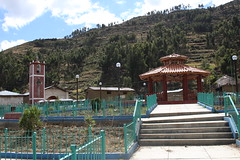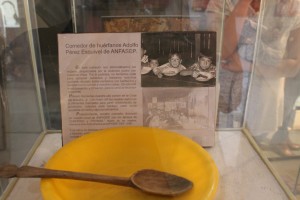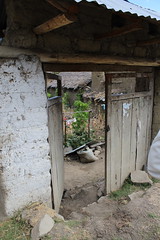In honor of World Refugee Day, I thought I’d share stories of internal displacement from the Peruvian conflict in the 1980s and 1990s and the effects of this displacement on present-day Peru. Throughout the EPAF field school, we have discussed the “battles for memory,” the competing narratives of victims and perpetrators, of the Shining Path and the Peruvian armed forces, of Fujimorism and the Truth and Reconciliation Commission, among others. One of these competing versions of the past that has been most striking during our days in the field are the narratives of people who fled the conflict sites and those who stayed behind.
Why they fled
The UN Guiding Principles on Internal Displacement define internally displaced persons as those who have been forced to flee or to leave their homes as a result of or to avoid the effects of “armed conflict, situations of generalized violence, violations of human rights or natural or human-made disasters,” and who, unlike refugees, have not crossed an international border. While this definition did not exist until 2001, the TRC found that at least 500,000 people were internally displaced during the Peruvian conflict. These are individuals who out of fear and insecurity fled to the coast or other safer areas of Peru.
Attacks and threats by the Shining Path and the military, and their resulting deaths and losses led people to seek refuge in mountain caves, in neighboring communities or in foreign cities, sometimes for a few days and other times permanently. A majority of those recruited, killed or disappeared were young men. In the absence of the men’s protection and working hands, these traditionally patriarchal communities descended into poverty and neglect, causing more people, mainly widows and children, to move.
Few people are seen in the streets of Tinca and most of the buildings are now abandoned.
Relocation and hardship
Mrs. Maura, a woman we interviewed in Tinca, told us how after the army took her son during a helicopter raid in 1984, she and her husband decided to abandon everything and flee with the rest of her children. Initially, they hid in the mountains just outside of the village, but eventually they decided to travel to Lima.
When they arrived in Lima, their situation did not improve much. They had nothing to eat and she had carried only a few of her kitchen items. At first they stayed in a camp-like site with several other people coming in from Ayacucho. “The people who have suffered the most are the villagers who didn’t leave and stayed in Tinca, but in the end everyone’s a victim,” says Mrs. Maura. “Those who went to Lima with nothing and those who stayed in Tinca with the violence.”
The displaced received no assistance from the government upon their arrival in the cities. The Peruvian state suspected those who had fled the peasant communities of being terrorists or Shining Path informants, in addition to refusing them due to deeply ingrained prejudice against indigenous groups. In the later years of the conflict, the International Committee of the Red Cross and other NGOs arrived in Ayacucho and Lima to give humanitarian aid to the displaced. Yet this aid was limited and not accessible to most of those in need.
Items and pictures from the ANFASEP Museum of Memory in Huamanga. ANFASEP is an association of relatives of victims of the conflict. The label reads: “In this community kitchen, us women displaced by the violence were fed with our children. Because of poverty, we didn’t have any money to buy utensils and we brought our wooden spoons; all of us came with small bowls and took the leftover food to our homes.”
Some economic migrants in Lima who preceded the conflict welcomed the displaced from their communities of origin, offering them housing and food. Over time, populations who had migrated in groups self-organized into communal sites and re-created their former communities in certain neighborhoods of Lima. For example, people from the Huanta and Accomarca communities formed neighborhoods of the same name in Lima.
Not all of the displaced found support in the receiving cities. Individual families and communities with a culture of self-reliance were less likely to integrate into previously established groups or new organizations, instead experiencing alienation from their new locations. As Percy, who I introduced in a previous entry, said during a group discussion: “When people migrate, they bring with them their celebrations and traditions, as well as their competitions.”
Like many others, Mrs. Maura could not adapt to life the city. She still felt scared and grew bored in an environment unfamiliar to her. She told us she would begin to cry when she saw men on the street that resembled her disappeared son. Mrs. Maura continued to express a desire to return to her village, until her children recently built her a new home in Tinca. She now spends most of her time in Tinca but says she often feels lonely because the houses are abandoned and the village is largely in ruins.
Tensions between those who stayed and those who left (and came back)
The situation for the displaced, and for those who didn’t leave the communities, worsened when during President Alberto Fijumori’s rule, the government began to encourage people to return to their native communities under the Project in Support of Repopulation (Programa Nacional de Apoyo a la Repoblación, PAR).
In 1993, the PAR program was created to support the rural areas that had been affected by terrorist violence. Although the program meant progress by acknowledging the existence of internally displaced persons, it also became a source of conflict among the communities. Some people were forcibly returned to places that remained unsafe; others fought when they tried to reclaim their abandoned land. Finally, many people abused the program, moving back to the communities temporarily to take advantage of the development funds while maintaining their main residence in the cities.
Villagers who never left their homes consider those who migrated divorced from the realities playing in the rural communities. A sense of heroism and pride fills the narratives of the people who remained in their native towns during the conflict. “I stayed behind to defend my community from the terrorists when most people chose to go to the cities,” another woman in Tinca told us. This discourse was further encouraged by Fujimori’s government, which praised communities that collaborated in counterterrorism efforts.
A few groups of displaced people formed associations in Huamanga and Lima, the main destination sites. One of the cases we studied and which illustrates well the complex relationships between the natives, the displaced and the repatriated is the case of the memorial museum in Huamanquiquia.
In 2006 the Association of Displaced Families of Huamanquiquia in Lima decided to build a memorial museum in Huamanquiquia. The museum displayed photographs and belongings of victims of the violence to honor their memory. However, because the museum was an initiative led by an organization based in Lima, the villagers in Huamanquiquia did not have ownership over the project and the local authorities had neither the interest nor the resources to maintain it. A couple of years after it opened, the museum closed and many of the items were lost.
 During the field school we visited the site of the former “House of Memory” museum in Huamanquiquia. The abandoned building represents another memory project that failed as a result of conflicting interests.
During the field school we visited the site of the former “House of Memory” museum in Huamanquiquia. The abandoned building represents another memory project that failed as a result of conflicting interests.
These accounts of internal displacement in Peru reflect various levels of exclusion. While the indigenous migrants who fled conflict areas experienced discrimination and other adversities in the cities, the populations that remained were also marginalized by the armed groups in power and by the displaced people who returned. Unfortunately, instead of finding unity in a shared experience of exclusion, the communities today continue to argue about who should be considered more or less of a victim and fight over entitlements to reparations.
Posted By Mariel Sanchez
Posted Jul 14th, 2015







2 Comments
Sarah Reichenbach
July 26, 2015
The pictures of Tima are so similar to Srebrenica. I think so often we think a conflict is over because the fighting and killing has stopped and we forget to think about the people who have to completely start over for decades after.